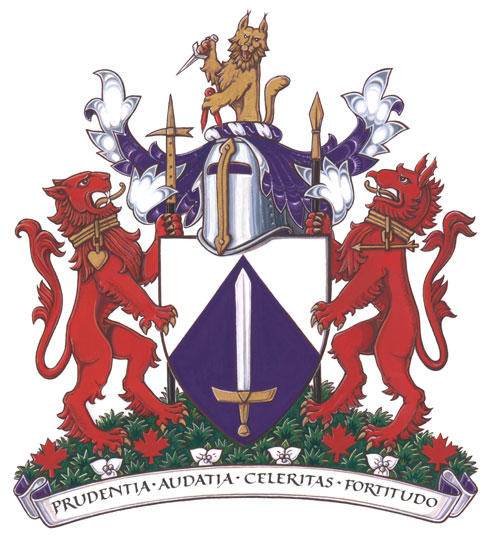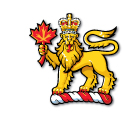- The Governor General of Canada

The contents of this Register are intended for research purposes only. The heraldic emblems found in the Register may not be reproduced in any form or in any media without the written consent of the Canadian Heraldic Authority and/or the recipient.
Academy of European Medieval Martial Arts
Toronto, Ontario
Grant of Arms, Supporters, Flag and Badge
January 15, 2008
Vol. V, p. 197

[ previous page ]
Blazon
Arms
Per chevron enhanced Argent and Purpure, a sword Argent hilted Or;
Crest
A demi-lynx guardant Or holding in the dexter paw a dagger Argent and in the sinister paw a pair of dividers Gules;
Supporters
Dexter a lion Gules gorged with a collar pendent therefrom a heart and supporting a halberd Or hafted Sable, sinister a tyger Gules gorged with a collar pendent therefrom an arrow and supporting a spear Or hafted Sable, both standing on a grassy mound set with maple leaves and trillium flowers proper;
Motto
PRUDENTIA • AUDATIA • CELERITAS • FORTITUDO;
Symbolism
Arms
The sword represents the medieval martial arts which the Academy is dedicated to studying.
Crest
The lynx represents one of the four attributes of the ancient fighting art outlined in the treatise Flos Duellatorum by Fiore dei Liberi (c.1410), specifically “prudentia”, meaning prudence or caution. The lynx is known for its keen eyesight, and the dividers it holds indicate the importance of precise measurements in combat. The dagger is one of the weapons used in medieval fighting.
Supporters
The supporters represent two other attributes from the dei Liberi work. The lion represents “audatia”, or courage, and is shown with a heart, which also represents courage in the manuscript. The heraldic “tyger” represents “celeritas” or swiftness. It is shown with an arrow, as tigers were reputed to be able to snatch an arrow in mid-flight. The halberd and spear are other weapons used in medieval combat. The compartment contains floral symbols of Canada and Ontario. The fourth attribute from the dei Liberi work, “fortitudo”, or strength, represented by an elephant, not shown here.
Motto
These four words are the attributes named in the de Liberi treatise, and mean “Prudence, daring, swiftness, and strength.”
